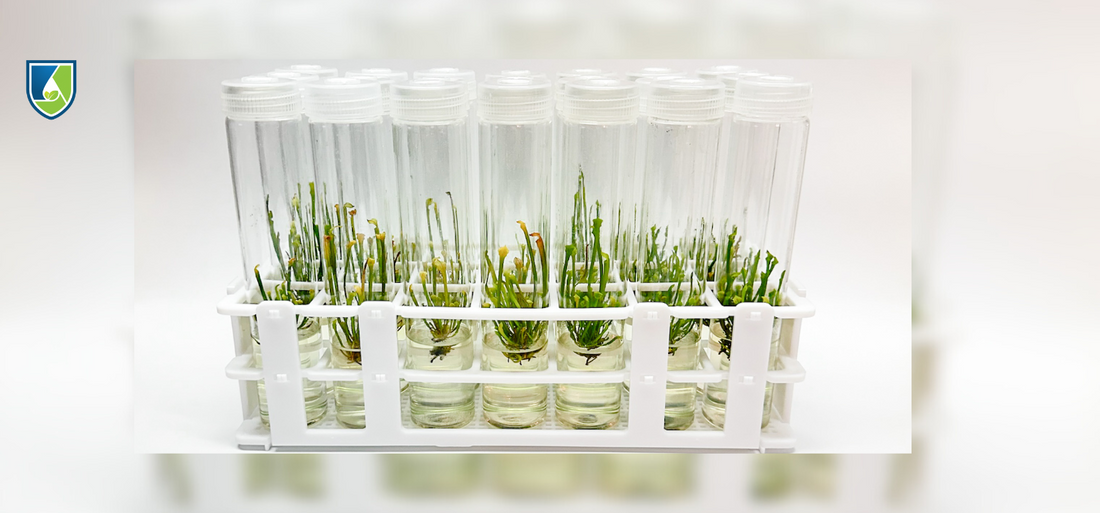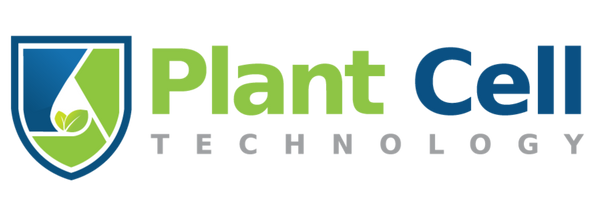
Hyperhydricity—What It Is And How To Avoid It?
As a content and community manager, I leverage my expertise in plant biotechnology, passion for tissue culture, and writing skills to create compelling articles, simplifying intricate scientific concepts, and address your inquiries. As a dedicated science communicator, I strive to spark curiosity and foster a love for science in my audience.


Introduction
Did you know hyperhydricity is one of the most common challenges of plant tissue culture?
In vitro cultivation can expose plants to suboptimal conditions like high humidity, inadequate lighting, and excess nutrients, resulting in anatomical, morphological, or physiological problems. One such issue is hyperhydricity.
Hyperhydricity, previously known as vitrification, is a physiological disorder in plant tissue culture. It is characterized by excessive water content and abnormal growth caused by factors like high humidity, wounding, and nutrient imbalances.
Remember: Hyperhydricity and vitrification are no longer the same terms, even though some culturists use them interchangeably.
Currently, the term 'vitrification' is used to describe two distinct processes related to tissue-cultured plant material:
- Abnormal morphology and physiology: In this context, vitrification refers to plant tissues that exhibit an abnormal appearance and function.
- Solidification: In cryopreservation, vitrification refers to the direct transition from a liquid to a solid state, preventing ice crystal formation during freezing.
To avoid confusion, it is recommended to use the term 'hyperhydricity' when describing plant material with abnormal morphological appearance and physiological function.
This will help clarify the distinction between these two important processes in plant tissue culture.
In this article, we will discuss the symptoms of hyperhydricity, its causes, and how you can protect your plant from this disorder.

Symptoms of Hyperhydricity
Hyperhydricity is a physiological disorder characterized by a glassy or translucent appearance of plant tissues due to excessive water content. This condition can significantly impact plant growth, development, and survival.
Key Symptoms of Hyperhydricity:
- Glassy or translucent appearance: Hyperhydric tissues often exhibit a vitreous or translucent quality due to their high water content.
- Reduced growth rate: Plants experiencing hyperhydricity may exhibit stunted growth and development.
- Abnormal morphology: Hyperhydric plants may have distorted or abnormal shapes, including thickened stems, short internodes, and twisted leaves.
- Chlorophyll deficiency: Hyperhydricity can lead to a reduction in chlorophyll production, resulting in yellowing or pale-colored leaves.
- Accumulation of starch granules: Large starch granules may accumulate in the plastids of hyperhydric plants.
- Cell hydration and intercellular spaces: Hyperhydric plants often have increased cell hydration, leading to the formation of large intercellular spaces and decreased cell adhesion.
- Hypolignification: Reduced lignification, or the formation of woody tissue, is commonly observed in hyperhydric plants.
- Stomatal dysfunction: Hyperhydric plants may have impaired stomatal function, leading to reduced gas exchange and increased water loss.
- Changes in enzyme activity: Hyperhydricity can disrupt the activity of various enzymes involved in plant metabolism.
- Ultrastructural changes: Hyperhydric plants may exhibit changes in cell structure, including damaged membranes, reduced mitochondrial number, and increased vacuolation.
Understanding these symptoms is essential for diagnosing hyperhydricity and implementing appropriate mitigation strategies.
Causes of Hyperhydricity
Understanding the causes, symptoms, and prevention strategies of hyperhydricity is crucial for successful plant propagation.
Causes of Hyperhydricity
- Environmental factors: High relative humidity, insufficient lighting, excess nutrients, and gas accumulation (particularly CO2 and ethylene) in the culture vessel can all contribute to hyperhydricity.
- Explant factors: The type of explant, its size, age, and genotype can influence susceptibility to hyperhydricity.
- Culture conditions: Factors such as the composition of the culture medium, the presence of growth regulators, and aeration conditions can also contribute to hyperhydricity.
Understanding the Role of Oxidative Stress inHyperhydricity
Many researchers believe that oxidative stress is a key factor in the development of hyperhydricity. Reactive oxygen species (ROS) are generated in plant tissues under stress conditions, including those associated with hyperhydricity. These ROS can damage cellular structures and disrupt various physiological processes.
Specific Factors Contributing to Hyperhydricity
- Nutrient imbalances: An excess of ammonium ions can disrupt nitrogen and carbon ratios, leading to reduced lignin and cellulose production, which can contribute to hyperhydricity.
- Hormonal imbalances: High concentrations of cytokinins can promote ethylene accumulation, which has been linked to hyperhydricity.
- Insufficient aeration: Lack of proper airflow in confined culture vessels reduces oxygen levels, resulting in hypoxia.
- Excess liquid or soft medium: Too much liquid medium or a soft gelling agent allows water to penetrate the intercellular spaces, causing osmotic shock.
- Epigenetic changes: DNA methylation patterns have been shown to influence the development of hyperhydricity, suggesting an epigenetic component to this disorder.

How To Deal With Hyperhydricity?
Dealing with hyperhydricity in plant tissue culture can be challenging, especially when working with unfamiliar plant genotypes. However, several strategies can help mitigate this issue and promote healthier plant growth. Here are some key techniques to manage hyperhydricity:
-
Improve Ventilation in Culture Vessels
Plants grown in sealed vessels often suffer from poor gas exchange, which can lead to hyperhydricity. Using ventilated vessels, such as PCT cultivation vessels with filters, can significantly enhance gaseous exchange. This improved ventilation helps plants adapt more easily, minimizing the risk of hyperhydration and promoting healthier growth. -
Optimize Light Intensity
Light intensity plays a critical role in tissue culture; incorrect levels can stress plantlets, increasing the chance of hyperhydricity. Adjusting the light intensity according to the specific needs of the plant species you're cultivating, combined with good ventilation, helps prevent excessive ethylene production and accumulation inside the vessels. -
Regulate Temperature
Temperature is another essential factor to monitor. If the growth room temperature is too low (below 24°C / 75.2°F), especially for tropical plants, the likelihood of hyperhydration increases. On the other hand, plants that thrive in cooler climates may hyperhydrate if temperatures are too high. Adjusting temperature settings to match the natural growing conditions of the species helps mitigate this risk. -
Adjust Culture Media Composition
Selecting the appropriate culture media is vital for plant growth. Although Murashige and Skoog medium is commonly used, alternatives like WPM, Gamborg, or DKW may be more suitable depending on the plant species. Reducing nitrogen levels and increasing calcium, iron, and magnesium can be beneficial for managing hyperhydricity. -
Increase the Concentration of the Gelling Agent
Hyperhydricity can also be reduced by increasing the concentration of the gelling agent or switching to a different one. This adjustment decreases the availability of water, limiting water uptake by the plantlets and thus reducing hyperhydration. -
Control Cytokinin Levels
Cytokinins, a type of plant hormone, are known to induce hyperhydricity in various species like bananas, cacti, and cannabis. Balancing cytokinin concentrations in the culture media can help slow down hyperhydration while still supporting shoot proliferation. -
Experiment with Exogenous Additives
Additives like salicylic acid, PEG, and polyamines have shown promise in reversing hyperhydricity in some cultures. While their effectiveness may vary depending on the species, these compounds offer a potential solution for controlling hyperhydration in future studies.

While hyperhydricity is a common challenge in plant tissue culture, different species have unique needs. The methods outlined here can be effective for certain plants but may not apply to others. Each plant should be studied individually to determine the best approach for managing hyperhydration.
How Does Plant Cell Technology Help In Your Process?
Plant Cell Technology offers a comprehensive range of solutions and services designed to streamline your tissue culture processes and enhance your overall success. Here's how we can support your journey:
- Expert Guidance: Our team of experienced professionals provides personalized support and advice, helping you navigate the complexities of tissue culture.
- Essential Supplies: We offer a wide range of high-quality products, including growth media, plant hormones, and equipment, to meet your specific needs.
- Innovative Bioreactors: Our Biocoupler™ bioreactor provides an efficient and reliable solution for plant multiplication.
- Master Classes and Training: Enhance your skills and knowledge with our expert-led master classes, covering a variety of tissue culture topics.
- Personalized Consultation: Get one-on-one guidance from our experts to address your specific challenges and optimize your tissue culture protocols.
By partnering with Plant Cell Technology, you can:
- Increase efficiency: Streamline your tissue culture processes and reduce operational costs.
- Improve outcomes: Enhance plant growth, development, and quality.
- Stay ahead: Access the latest technologies and innovations in tissue culture.
- Gain valuable insights: Benefit from our expertise and experience in the field.
Let us help you achieve your tissue culture goals. Contact us today to learn more about how our solutions can make a difference for your business.
Blog Categories
View by Level
Popular Blogs

How Samantha Bridges the Gap Between the Nursery and the Lab
The Introduction Building a tissue culture program from the ground up requires more than just scientific knowledge—it requires the grit...
Read More
Understanding The Synthetic Seed Technology
Introduction Let’s be honest: traditional plant propagation can be a logistical nightmare. If you’re working with recalcitrant species—those stubborn plants...
Read MoreSubscribe to Our Newsletter
6 comments
Hi Sergey,
Thank you so much for your kind words! I am glad to know that you have been reading my articles and that they have helped you in your tissue culture journey.
Stay tuned for more informative blogs.
Thanks for this article. It helps me fix my errors in tc and prevent hyperhydricity
Thanks for this article! It helps me fix hyperhydricity in my tc
Hi, dear Anjali. I’m a big fan of pct blog. Hyperhydricity is my problem no.1, but your article is helped see mistakes in my tc. Thank you so much
Tissue culture media, gel for sale?








Join the conversation
Your email address will not be published. Required fields are marked